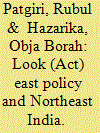|
|
|
Sort Order |
|
|
|
Items / Page
|
|
|
|
|
|
|
| Srl | Item |
| 1 |
ID:
183719


|
|
|
|
|
| Summary/Abstract |
The Look East Policy, now rechristened as the Act East Policy, was launched by India in response to the changing geo-strategic and geo-economic realities of the post-cold war era. The Look (Act) East Policy, however, is also being envisioned as a new engine of economic growth for Northeast India. The failure of India’s past experiment with the development of Northeast—ranging from protecting diverse cultural mosaic and gradual integration of tribal economies and institutions to modern political and economic structures to protecting the region through excessive security deployment and from politically accommodating different sub-national and ethnic aspirations to the pouring of developmental funds through increased public expenditure—prompted the Government to propose a new developmental model for the region under the Look (Act) East Policy. Under this model, the development of the Northeast is sought to be achieved through cross-border economic integration with the neighbouring Southeast Asian countries. One of the major hindrances underlying the development of Northeast India is its lack of access to the market because of the landlocked, bounded and insular character of the region (Verghese, 2001). Transnational economic integration with the neighbouring countries, therefore, is being looked at as possible means to provide Northeast India with its much-needed access to the market. Given the geographical proximity and historical-cultural ties between the Northeast region and Southeast Asian countries, the Look (Act) East Policy can facilitate a process of economic integration of Northeast India with the Southeast Asian countries. The expectation is that such integration would promote trade and investment in the region to bring economic growth and prosperity. This model of development as conceptualised under the Look (Act) East Policy is essentially neoliberal in character as it tries to develop the Northeast through the free play of global market forces. The state is supposed to merely facilitate the trans-regional economic integration by providing the basic necessary infrastructure. Accordingly, under the Look (Act) East Policy, India has undertaken a number of initiatives such as building sub-regional institutional and physical connectivity to promote such economic integration of Northeast with the Southeast Asian neighbours. Thus, there seems to be a growing consensus on the part of both the government and members of civil society in favour of this trans-regional market economy model proposed under the Look (Act) East Policy. Against this background, the present article endeavours to evaluate the success of the Look (Act) East Policy in terms its ability to accelerate the pace of development in the Northeast.
|
|
|
|
|
|
|
|
|
|
|
|
|
|
|
|
| 2 |
ID:
148494


|
|
|
|
|
| Summary/Abstract |
India’s neighbourhood policy seems to be devoid of any strategy to integrate national interests with the concerns of border regions like Northeast India. India’s security-centric approach prevented a cooperative relationship from emerging with its neighbours, while a deeper and intense engagement with them would have benefitted India and helped solve many of the problems that Northeast India is facing today. However, the recent move by India under the Act East Policy to cultivate a much closer relationship with its eastern neighbours is full of possibilities to make India’s neighbourhood policy more accommodative and sensitive towards the needs of Northeast India. In the light of this, the proposed article intends to examine the nature of India’s neighbourhood policy, to assess its implications for the Northeast and finally, to examine whether the recent transnational engagements can initiate development of the Northeast by relieving it from its peripheral and landlocked status.
|
|
|
|
|
|
|
|
|
|
|
|
|
|
|
|
| 3 |
ID:
190750


|
|
|
|
|
| Summary/Abstract |
The underdevelopment of Northeast India is quite often explained in terms of economic isolation primarily on account of its geographical peripherality. To address this challenge, a new imagination, through the Look (Act) East Policy has been proposed. This approach, makes India’s Northeast the centre of a unified economic, physical and social space through its integration with the trans-border neighbouring regions. In this article, an attempt has been made to examine the logic of developing an ‘extended Northeast’ and how it has been sought to be realized. The article argues that the actualization of this proposed integrated space is ridden with serious difficulties and the internal fragmentation of Northeast India and the exceptional rules and administrative arrangement that are in place in the region along with the geopolitical compulsion of India may act as significant barriers in this regard. And most importantly there are apprehensions that the proposed integrated space may lead to the appropriation of resources of the Northeast by the corporate houses without benefiting the people of the region.
|
|
|
|
|
|
|
|
|
|
|
|
|
|
|
|
|
|
|
|
|